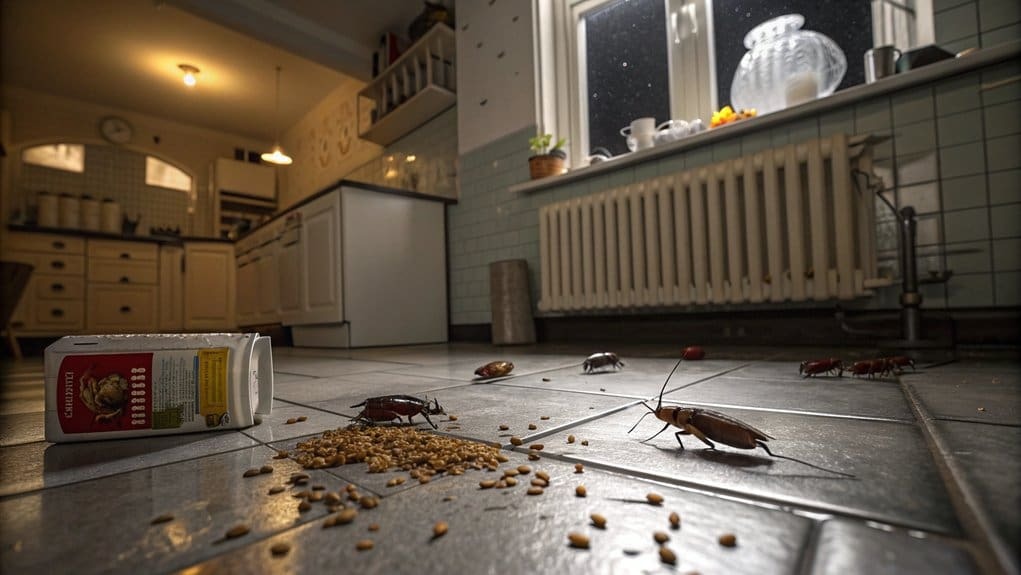Creepy-Crawly Comebacks: Why Cockroach Infestations Are Rising Again in UK Cities

From London flats to Birmingham takeaways, cockroaches are making a comeback. Here’s why—and what you can do to stop them.
You’re seeing more cockroaches in UK cities because record-warm summers since 1884 and humid, heated homes accelerate breeding and extend nocturnal activity, driving a 14% annual rise. Roaches spread E. coli and Salmonella, and their droppings and skins trigger asthma. Early signs include black droppings, shed skins, ootheca, and musty odours near heat and moisture. Act fast: clean, seal gaps, dry leaks, containerize food, and set traps. Practical steps and inspection tactics can cut risk and confirm pressure.
Key Takeaways
- Record-warm summers and prolonged heat accelerate cockroach breeding cycles and extend active seasons.
- Indoor microclimates—warm, humid, and food-rich—create ideal refuges for urban populations.
- Climate trends and central heating keep temperatures higher year-round, boosting survival and reproduction.
- Increased food waste and clutter in dense housing provide abundant resources and harbourage.
- Small structural gaps around pipes and doors enable easy movement and rapid spread between properties.
What’s Driving the Surge in Urban Cockroaches
Although multiple factors intersect, the surge in urban cockroaches is primarily driven by a 14% year-on-year rise in infestation reports, a record-warm summer since 1884 that accelerated breeding cycles, and prolonged heat and humidity from both climate trends and indoor central heating.
You’re seeing urban cockroach infestations expand because those metrics create ideal conditions: higher ambient temperatures, longer active periods, and faster reproduction.
As autumn begins, heated flats sustain suitable microclimates, pulling pests indoors. A decline in hygiene standards—missed waste collections, inconsistent cleaning—adds accessible food and harborage, especially in dense nodes like Birmingham.
Ongoing climate change lengthens seasons, making spikes persistent, not episodic.
Health Risks You Can’t Ignore
Rising cockroach numbers don’t just strain city services; they elevate direct health risks inside homes and workplaces.
You face measurable exposure pathways: cockroach activity spreads harmful bacteria such as E. coli and Salmonella onto food-contact surfaces, increasing gastrointestinal illness risk.
Droppings, shed skins, and saliva contain potent allergens that trigger asthma and worsen eczema, especially in children.
A persistent musty or oily odour often correlates with higher population density and greater contamination probability.
Urban density and poor hygiene create ideal breeding niches and stable food sources, amplifying transmission vectors.
Because cockroaches are nocturnal, unseen reservoirs can escalate health risks before you notice.
How to Spot an Infestation Early
Before an infestation takes hold, confirm early indicators with targeted checks: scan floors, worktops, and cupboard shelves for pepper-like black droppings; locate shed skins and brown, oval ootheca near heat and moisture sources; note any persistent musty or oily odour; and conduct nocturnal inspections with a flashlight behind appliances, under sinks, and along wall-floor junctions.
Spot early signs: droppings, shed skins, ootheca, musty odour—inspect at night behind appliances and sinks.
- Map entry points: gaps under doors, utility penetrations, vents; seal cracks and crevices.
- Track activity windows: sightings in daylight suggest high population density.
- Audit food hygiene: store airtight, clean residues, remove waste nightly.
- Place monitors: sticky traps near warm harborage zones to verify presence and guide Pest Control.
Immediate Actions to Take if You See One
Even a single cockroach sighting warrants swift, structured action: clean and disinfect nearby surfaces to remove food residues and pathogens, then inspect adjacent warm, humid zones (under sinks, behind appliances) for activity.
Reduce access to food by containerising staples, emptying bins, and wiping spills. Seal gaps with caulk or foam around pipes, skirting, and cable penetrations to block entry.
Deploy glue traps and enclosed bait stations along runways to quantify pressure and intercept movement. Log date, time, and location to track patterns.
If you detect multiple individuals, droppings, or oothecae, call a professional exterminator. Sustain cleanliness and fix moisture to deter escalating infestations.
Need Expert Cockroach Removal in London & Essex?
Bugwise Pest Control provides discreet, BPCA-certified cockroach control services for homes and businesses across Romford, Dagenham, and beyond.
Prevention Strategies That Actually Work
While a single roach suggests nearby harbourage, prevention hinges on eliminating attractants and entry. You’ll cut risk by targeting cleanliness, sealing entry points, controlling food sources, reducing moisture, and scheduling inspections. Aim for measurable habits that keep your home aligned with community standards and resilient.
- Clean nightly: degrease hobs, wipe surfaces, vacuum crumbs. Verify with a white cloth test; residues fuel foraging.
- Seal gaps around pipes, skirtings, and floor-wall junctions with silicone or escutcheons; install door sweeps.
- Store food in airtight containers; double-bag rubbish and use lidded bins; empty daily.
- Fix leaks, dry sinks, ventilate; inspect behind appliances and under cabinets weekly.
Frequently Asked Questions
Why Do Cockroaches Suddenly Appear in the UK?
They appear because seasonal factors and warmer homes activate cockroach behavior in urban environments. You’re seeing a 14% rise; poor hygiene and humidity amplify risks. Use integrated pest control: sanitation, exclusion, monitoring, targeted baits, and heat treatments to protect community health.
Which Country Has the Most Cockroaches?
The United States hosts the most cockroach species. You’ll see diverse cockroach habitats thrive via climate impact, dense urban infestation, and variable sanitation. You prioritize pest control metrics: over 70 species documented, outpacing Germany, Brazil, India, and Australia in richness.
Why Do I Have Cockroaches in My House if I’m Clean?
You have cockroaches despite cleanliness because they exploit tiny gaps, moisture, and warmth. Reject common myths: clean homes aren’t immune. Prioritize pest prevention: seal entry points, fix leaks, monitor droppings. For effective extermination, deploy baits, IGRs, and professional follow-up.
Do Humans Scare Cockroaches?
Yes. You trigger flight responses; cockroach behavior detects vibrations and airflow, prompting rapid retreat. However, human interaction rarely deters infestations in urban environments. You’ll need integrated pest control—sanitation, exclusion, baits, and monitoring—to offset their nocturnal, adaptable survival strategies. You’re not alone.



